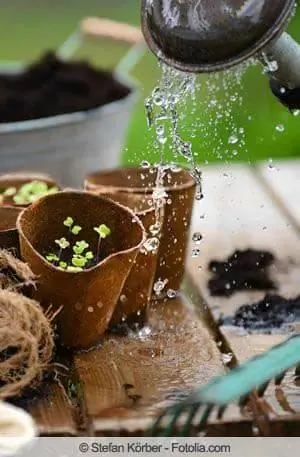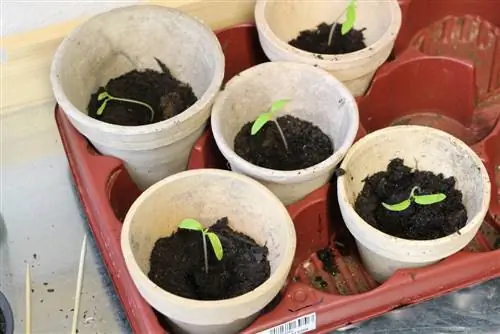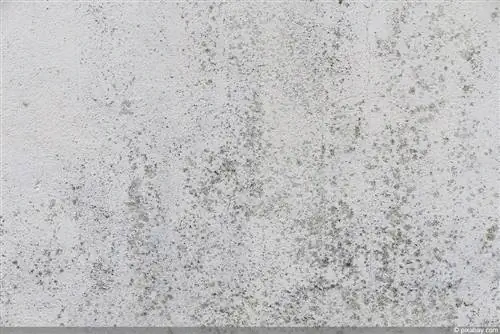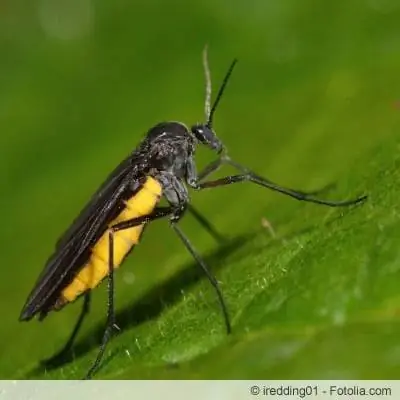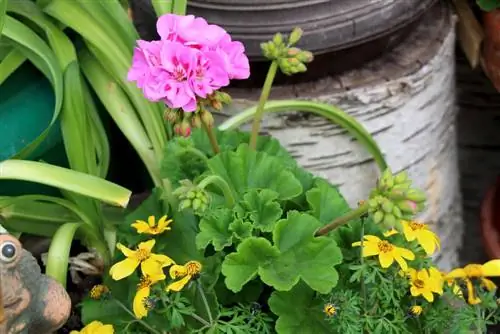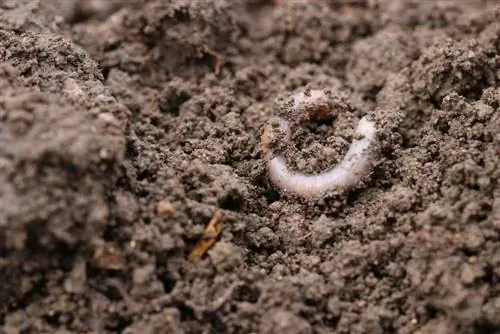- Author admin [email protected].
- Public 2023-12-17 03:39.
- Last modified 2025-01-24 12:45.
No matter how careful you are with your plants and flowers, it can always happen that a layer of mold forms on the potting soil, which is not only unpleasant but can also be harmful to the plants and your own he alth. For this reason, you are well advised to do something quickly against the mold and do everything in your power to ensure that it avoids your potting soil in the future.
The reasons
The causes of mold on earth can be quite diverse. It is therefore important to analyze in advance exactly why mold formation occurs. This is the only way to remove mold effectively and in the long term.
Waterlogging
So there is definitely the possibility that you are watering your plants too generously and the resulting waterlogging will encourage mold to form. Mold likes it moist. You probably know this from the wet winter months, when you have to ventilate particularly well to prevent mold from forming in the apartment. If the soil is kept moist at all times, it provides an interesting and welcome base for the white fluff.
In addition, the floor is too firm. If this is the case, the water can only be absorbed to a limited extent. The waterlogging that also forms is the ideal breeding ground for mold. Therefore, ensure regular but not too intensive watering. Also make sure that the soil is always well loosened so that the water can penetrate quickly. In this way, you not only avoid unnecessary moisture, but also provide your plants with the vital elixir.
If the waterlogging cannot be prevented by normal means, then the best thing to do is to use drainage. With a little gravel and coarse sand you can quickly create this and the water can collect in it without causing much damage.
Tip:
How often and in what quantity you need to water your plants, please refer to the instructions, which you will usually find on the signs attached to the plants when you purchase them. They not only contain information about the ideal location, but also tips for watering.
The watering behavior
Each plant has its own water consumption, which you should stick to. However, if this causes waterlogging and thus mold formation, it won't help anyone. Therefore, try to water the affected plants from below if possible. This means that the upper layer of the earth remains largely dry and the mold has little chance of taking hold.
The quality of the earth
The quality of the soil can also play a decisive role. If it is of poor quality or is already very old, mold may form.
Therefore, only buy high-quality soil and replace the soil in your flower pots regularly. This means that not only do your plants receive enough nutrients. You will also avoid unpleasant mold and will enjoy your plants more.
Make sure that the soil is not already moldy before you use it. If stored unfavorably, mold can form due to condensation between the soil and the packaging film. Therefore, do not store the soil for too long, but only buy it when you really need it.
Also loosen the purchased soil a little with sand. This means the earth is lighter and more air-permeable and waterlogging can only occur to a limited extent. And if you regularly loosen the surface of the pot with a small rake or fork, the soil can dry out more quickly and therefore does not provide a breeding ground for the unwanted mold.
Tip:
Buy your soil from specialist retailers. There you will find controlled quality.
The planters
When choosing the right planters, you should make sure that they always have a drain. Excess water can be collected in a planter or small bowl and, if necessary, poured away. Clay pots also absorb excess water and do everything to prevent mold from forming.
Create clean conditions
Even if it's hard to believe, the cleaner and more careful you are when repotting your plants, the lower the risk of mold formation.
So don't just rely on a clean workplace when you work with your plants. Always use clean plant pots that are free of old soil residues and therefore possible mold spores. The soil should also always be fresh and not used up by old plants.
Not only clean the plant pot before planting a new plant, but also always clean the balls of the plants before placing them in a new pot with new soil. Remove as much of the old soil residue from the plant ball as possible. Even if you don't see any mold there, it's possible that the spores have already settled there.
Tip:
The most thorough way to clean the plant pot is to use a natural vinegar cleaner. You are welcome to use a coarse brush and plenty of warm water. At the end, don't forget to rinse thoroughly so that the pot is free of any vinegar residue.
Alternative treatment methods
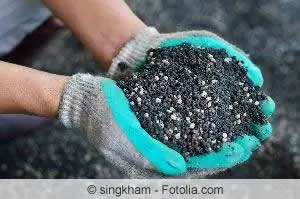
Various gardening tips from grandmother's times can also help against mold. Chamomile is said to have good results in combating mold. Therefore, make a relatively strong chamomile tea, let it cool down and water the affected plants with it. The result should be definitely worthwhile.
Important questions compact
How harmful is mold?
Mold not only harms plants, but also people. It tends to spread from the ground into the air, which can be particularly bad for allergy sufferers and asthmatics.
When can you repot?
Plants are usually repotted in spring. However, if mold appears, action must be taken immediately. Then repotting is possible at any time of the year.
How do you protect yourself from waterlogging?
If the plants need a lot of water, there should always be loose soil. If waterlogging occurs despite all of this, we recommend drainage that effectively absorbs the moisture and stores it for the plants.

